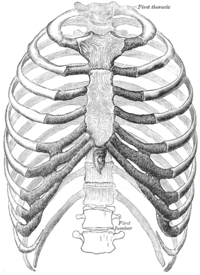
Photo from wikipedia
ABSTRACT Sternoclavicular Joint (SCJ) injuries account for Click to show full abstract
ABSTRACT Sternoclavicular Joint (SCJ) injuries account for <3% of shoulder injuries. Anterior dislocations are far more common than posterior dislocations, but proper recognition is essential as posterior injuries are potentially life threatening. The computed tomography (CT) scan is the gold standard in determining the direction of the SCJ injury, and furthermore can help to determine the difference between medial clavicle fractures through an open physis and pure dislocations. Since the medial clavicle is one of the last physes to close and does not fuse until as late as 25 years of age in males, SCJ injuries in this age group most often represent physeal injuries, however the treatment is similar to that for SCJ dislocations. Closed reduction maneuvers may be successful for the acute posterior SCJ dislocation, but operative reduction and repair is the gold standard of treatment. Anterior dislocations are not amenable to closed reduction due to deforming forces which cause recurrent dislocation but are thought to best be treated with closed management with the expectation for resolution of pain. Operative management of painful or unstable chronic dislocations includes medial clavicle resection and ligament reconstruction with allograft tendon in the setting of sternoclavicular instability.
Journal Title: Journal of orthopaedic trauma
Year Published: 2023
Link to full text (if available)
Share on Social Media: Sign Up to like & get
recommendations!